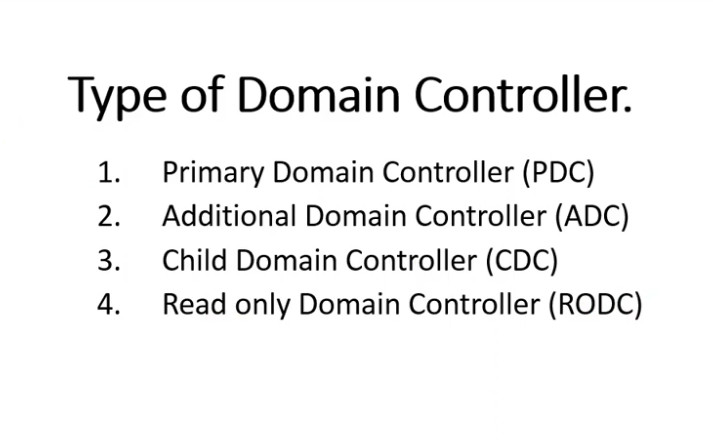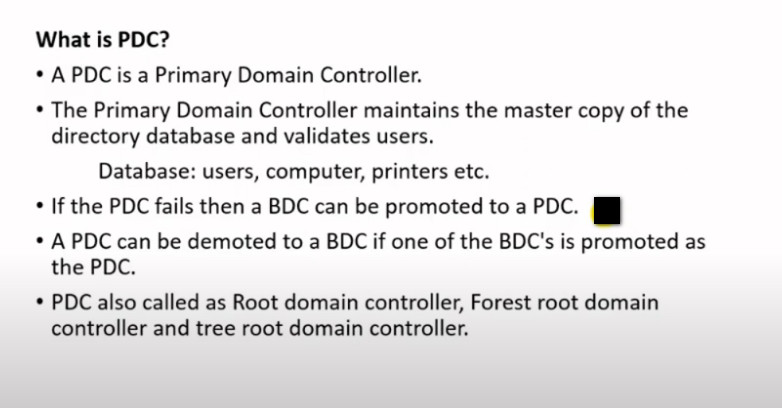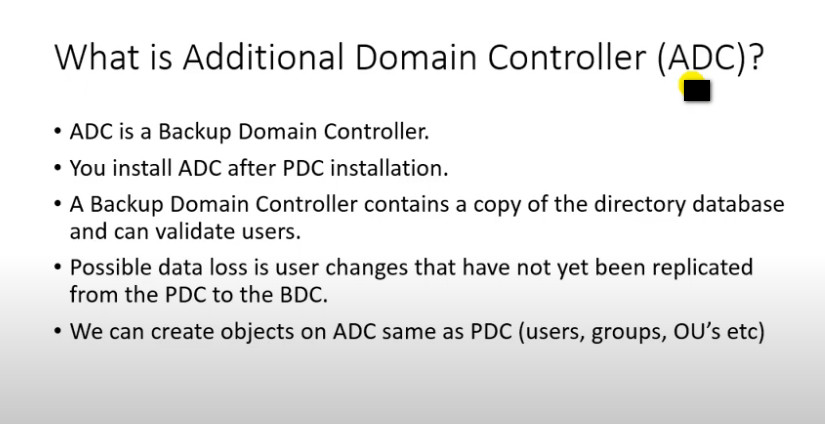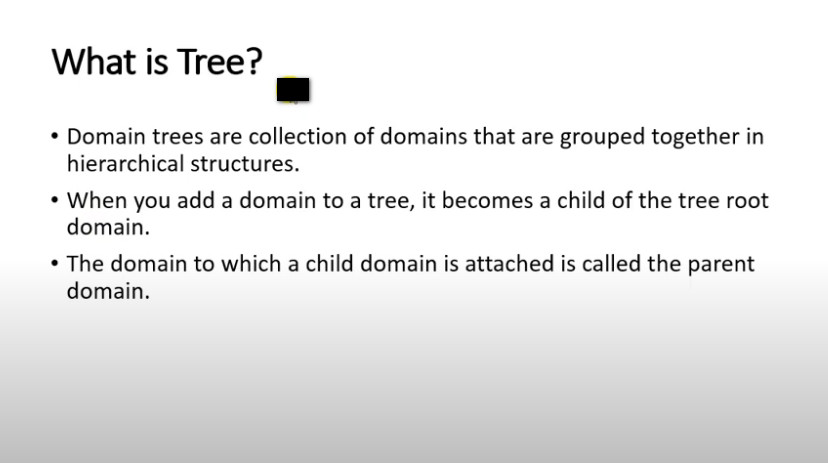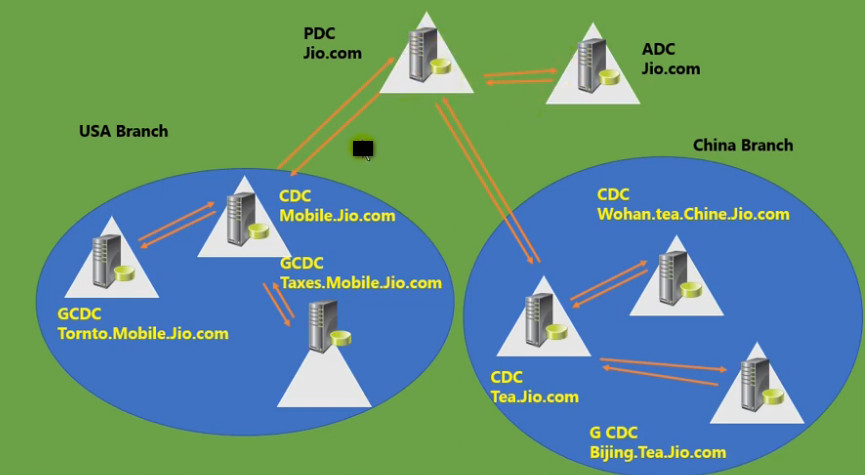A Domain Controller (DC) is a server in a Windows Server environment that is responsible for managing authentication and authorization within a domain. It serves as the backbone of a Windows-based network, specifically in environments using Active Directory (AD), which is Microsoft’s directory service. A Domain Controller holds the directory information, enforces security policies, and ensures that network resources are accessed by the correct users or systems based on their permissions.
Key Functions of a Domain Controller:
Authentication:
- A Domain Controller verifies the identity of users, computers, and services when they log into the network. This process is done through username/password verification and Kerberos authentication.
Authorization:
- Once a user or computer is authenticated, the Domain Controller checks its permissions and group memberships to determine what resources the user or computer is allowed to access (e.g., files, printers, applications).
Active Directory (AD) Database:
- The Domain Controller stores the Active Directory database, which contains information about all the objects in the network. These objects include users, groups, computers, printers, and other resources. The database is updated when changes are made, such as user password changes or the creation of new user accounts.
Group Policy Management:
- Domain Controllers enforce Group Policy settings across the network. These are configurations applied to users and computers that govern things like security settings, password policies, and user environment settings.
Replication:
- Domain Controllers replicate directory data with other Domain Controllers within the same domain or across different domains in the Active Directory forest. This ensures that all Domain Controllers have up-to-date information, maintaining consistency and fault tolerance across the network.
DNS (Domain Name System):
- A Domain Controller often also acts as a DNS server. DNS is used to resolve domain names into IP addresses. It helps clients find the Domain Controller and other network services by name.
Time Synchronization:
- A Domain Controller is responsible for maintaining time synchronization across the domain. Accurate time is critical for security protocols like Kerberos, which rely on time stamps for authentication.
Types of Domain Controllers:
- Primary Domain Controller (PDC) (Legacy): In older versions of Windows, the PDC was the central DC for managing authentication. In modern environments, the PDC Emulator role in AD serves this purpose.
- Backup Domain Controller (BDC) (Legacy): The BDC was used in older versions of Windows to replicate data from the PDC but could not make changes. In modern AD, all DCs are multi-master, meaning they can make changes and replicate data.
- Read-Only Domain Controller (RODC): A special type of DC that holds a read-only copy of the AD database, commonly used in remote locations for security reasons.
- Additional Domain Controller (ADC): Any additional DC that provides redundancy and load balancing for a domain.
Importance of Domain Controllers:
- Centralized Management: DCs allow network administrators to manage resources, users, and security policies centrally, making it easier to configure and maintain large networks.
- Security: DCs are crucial for enforcing network security policies and authenticating users, which helps prevent unauthorized access to network resources.
- Fault Tolerance: Having multiple DCs ensures that if one DC goes down, others can still provide authentication and other AD services, ensuring network availability.
Example:
In a typical corporate network, a user trying to log in to the network will have their login credentials verified by the Domain Controller. The Domain Controller will check if the credentials are correct, ensure the user has permission to log in, and grant access to network resources like file servers, printers, or applications.
In Summary:
A Domain Controller is an essential server in a Windows Server environment that is responsible for managing authentication, authorization, security policies, and directory services across a domain, allowing administrators to centrally manage users, groups, and resources. It is crucial for maintaining a secure and organized network infrastructure in larger organizations.
In the context of Active Directory (AD) on Windows Server, a Domain Controller (DC) is responsible for managing user authentication, authorization, and access control within a domain. When it comes to Active Directory Forests, a forest is the highest-level container in an Active Directory structure. It can consist of multiple domains and domain controllers, and each domain controller in the forest has specific roles and responsibilities.
Here are the types of Domain Controllers that exist in a Windows Server forest and how they function in an AD environment:
1. Domain Controllers (DC)
- Definition: A Domain Controller in an Active Directory forest is responsible for authenticating and authorizing users and computers within a domain. It stores a copy of the Active Directory database (which includes user accounts, security policies, group memberships, etc.) and replicates this data with other domain controllers in the forest.
- Role: The role of a Domain Controller is the same across all domains in a forest; it can be responsible for validating user credentials, enforcing security policies, and ensuring network resources are accessible based on user rights.
2. Global Catalog Server
- Definition: A Global Catalog Server is a specialized domain controller that holds a partial, read-only copy of every object in the forest. It contains a subset of attributes for each object (such as users, groups, and computers) from all domains within the forest.
- Primary Role:
- Search: It allows users and administrators to search for objects across the entire forest, not just within a single domain.
- Logon: It is crucial for user logon processes in multi-domain environments. If a user tries to log on from a domain other than their own, the Global Catalog is queried to locate the user.
- Deployment: Global Catalogs are typically deployed on domain controllers and can be configured as Global Catalog Servers to improve search functionality and logon performance across the forest.
3. Read-Only Domain Controller (RODC)
- Definition: A Read-Only Domain Controller (RODC) is a special type of Domain Controller that contains a read-only copy of the Active Directory database. It cannot make any changes to the AD database, but it can perform authentication and other read-only queries.
- Primary Role:
- Branch/Remote Offices: RODCs are ideal for environments where full Domain Controllers cannot be deployed due to security or physical constraints. For example, in remote or branch offices with limited security infrastructure or unreliable network connectivity, RODCs provide a local, read-only copy of the AD database.
- Credential Caching: RODCs can cache credentials locally to improve logon times for users in remote locations.
- Security Benefits: Since the RODC does not have writable access to AD, it provides an extra layer of security, especially in untrusted or less secure locations.
4. PDC Emulator (Primary Domain Controller Emulator)
- Definition: The PDC Emulator is an important FSMO (Flexible Single Master Operations) role in Active Directory. It is a special role assigned to one Domain Controller per domain in the forest. While all domain controllers in a domain are technically equal (multi-master replication), the PDC Emulator has specific responsibilities that it performs on behalf of the entire domain.
- Primary Role:
- Password Changes: The PDC Emulator is responsible for processing password changes and ensuring that they are propagated throughout the domain in a timely manner.
- Time Synchronization: The PDC Emulator serves as the authoritative time source for the domain, ensuring that all DCs and machines are synchronized with the correct time.
- Legacy Support: For compatibility with legacy Windows systems (pre-Windows 2000), the PDC Emulator functions as the “primary” controller for certain tasks.
- Account Lockouts: It also handles account lockout policies and is the authoritative source for account lockout events.
5. Additional Domain Controller (ADC)
- Definition: An Additional Domain Controller (ADC) is simply any domain controller in an Active Directory environment that supports redundancy and high availability. ADCs replicate the Active Directory data from other Domain Controllers to provide fault tolerance and load balancing.
- Primary Role:
- Redundancy: ADCs ensure that there is no single point of failure for authentication and authorization services. If the primary DC goes down, other ADCs can take over and continue to provide service.
- Load Balancing: In larger environments, ADCs can help distribute the load for handling client requests, improving overall performance.
- Replication: ADCs replicate the changes made to the AD database from other DCs in the domain.
6. Forest Root Domain Controller
- Definition: The Forest Root Domain Controller is the first Domain Controller in the root domain of a forest. This domain controller plays a critical role in the forest’s AD infrastructure and often holds special roles, including some FSMO roles.
- Primary Role:
- Forest-Wide Functions: It is the starting point for building an Active Directory forest and is responsible for setting up forest-wide policies and schema.
- FSMO Roles: The Forest Root Domain may host key FSMO (Flexible Single Master Operations) roles like the Schema Master and Domain Naming Master roles that are critical for AD replication and schema changes across the forest.
7. Multiple Domain Controllers in a Forest
- Definition: In a multi-domain forest, each domain can have one or more Domain Controllers. Each Domain Controller within a domain is responsible for replicating data and handling authentication and authorization requests within that specific domain.
- Primary Role:
- Replication: All Domain Controllers in a domain will replicate AD data with each other, ensuring that the directory information is consistent across the entire domain.
- Fault Tolerance: Multiple Domain Controllers in a domain ensure that services are still available even if one of the DCs fails.
Summary of Domain Controllers in a Windows Server Forest:
- Domain Controllers (DC): Responsible for user authentication, security policies, and managing Active Directory in a domain.
- Global Catalog Server: A DC that holds a partial replica of all objects in the forest and facilitates cross-domain queries and logons.
- Read-Only Domain Controller (RODC): A DC with a read-only copy of AD, used in remote locations for security and caching purposes.
- PDC Emulator: A DC that handles password changes, time synchronization, and legacy support in the domain.
- Additional Domain Controller (ADC): A DC that provides redundancy and fault tolerance in the domain by replicating data from other DCs.
- Forest Root Domain Controller: The first DC in the root domain of a forest, responsible for forest-wide functions.
- Multiple Domain Controllers: Each domain in a forest may have multiple DCs for replication, fault tolerance, and load balancing.
Each of these domain controllers serves a specific role in maintaining the integrity, availability, and security of the Active Directory forest and its domains. They work together to provide centralized management, authentication, and resource access across the entire organization.


